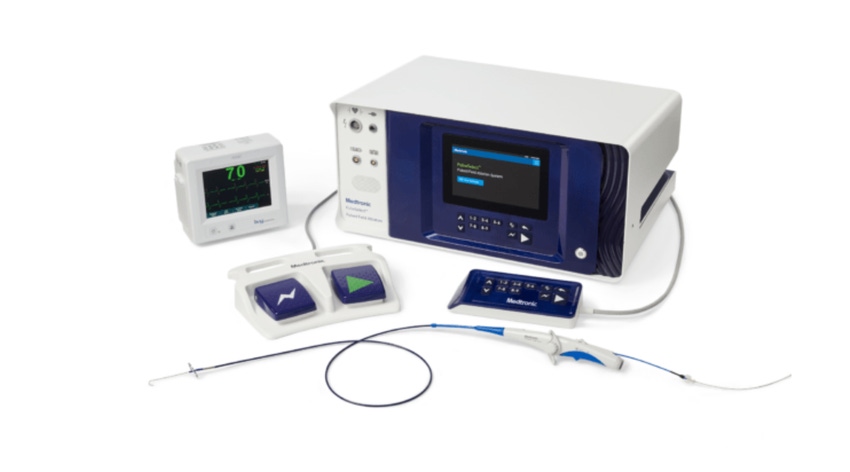Medtronic Makes a Double Play for Atrial Fibrillation
Medtronic scored CE marks for its pulsed field ablation and cryoablation console devices to treat atrial fibrillation.
November 22, 2023

Medtronic scored a double CE mark win for its PulseSelect pulsed field ablation (PFA) system, designed to treat atrial fibrillation, and the Nitron CryoConsole, designed to optimize workflow for cryoballoon ablation.
The PulseSelect system follows the company's CE mark in March for the Affera mapping and ablation system and sets Medtronic apart in the increasingly competitive PFA market.
"We are now the only company with approved catheters for both single shot and focal PFA," Medtronic CEO Geoff Martha said during the company's earnings call earlier this week.
Medtronic expects to launch the PulseSelect system in Europe early in 2024. Martha noted that FDA is currently reviewing the company's PulseSelect submission, and the company anticipates being among the first with a PFA catheter in the U.S. market.
Pulsed field ablation has been touted as a promising new ablation modality for the treatment of atrial fibrillation. This ablation method is intended to ablate heart tissue via the creation of a therapeutic electric field instead of using thermal energy sources such as radiofrequency ablation or cryoablation.
PulseSelect uses a non-thermal approach to preferentially target the pulmonary veins for ablation, avoiding unwanted injury to surrounding structures, which is a risk of current ablation technologies (thermal energy sources). The catheter utilizes a biphasic waveform, a built-in over-the-wire design and 20-degree forward tilt to support procedural maneuverability, reliability, and safety, as demonstrated by the PULSED AF trial. Based on data from the trial, the catheter has demonstrated efficient pulmonary vein isolation with an average of 30 seconds of total energy delivery time to isolate all veins.
“The electrophysiology community is eagerly awaiting new innovation to enhance the safety and efficiency of [atrial fibrillation] ablation. PulseSelect is specifically engineered to deliver pulsed field energy safely and maneuvers well, with great overall control of the energy applications,” said Lucas V.A. Boersma, MD, PhD, a cardiologist at St. Antonius Hospital in Nieuwegein, The Netherlands, and a professor of cardiology at Amsterdam University Medical Centers, University of Amsterdam, The Netherlands. “The safety profile shown by the PulseSelect system in its global pivotal study is one of the best compared to today’s standard of care for catheter ablation technologies.”
The PulseSelect system is designed as a plug-and-play system, meaning it can be used with any mapping system or with fluoroscopy. As an added safety feature, the design also includes a phrenic nerve test pulse, which acts as a non-therapeutic low voltage pulse that provides a preemptive assessment of catheter proximity to the phrenic nerve before delivering a therapeutic application. The design also features fixed spacing for the nine-electrode catheter produces a predictable and consistent electric field for contiguous ablation.
Medtronic counts its cardiac ablation solutions business among its highest growth markets.
"Over the coming years, we expect this business to be a very meaningful growth driver for Medtronic," Martha said.
The race for pulsed field ablation market share is intense
Treating AF with ablation (electrophysiology/EP) is an $8 billion market with a long runway, according to Travis Steed, a medtech analyst at Bank of America. Steed estimates that only about 15% of the eligible 2.5 million U.S. patients with AF are currently being treated with ablation (worldwide, around 650,000 ablations versus 35 million patients with AF, he notes).
So, it's no wonder Medtronic, Johnson & Johnson, and Boston Scientific are all jockeying for market share in pulsed field ablation. There are also several private companies developing PFA technology.
In a February 24 report, Steed wrote that pulsed field ablation looks to be safer and faster and could potentially revolutionize the way ablations are done today and expand the market. The key question comes down to data, as PFA must continue to prove durability and safety in line with thermal-based options such as radiofrequency ablation or cryoablation, the analyst noted.
"Our doc conversations suggest that physicians want to see data on each platform as all PFA systems are not created equal," Steed wrote.
About the Author(s)
You May Also Like



.png?width=300&auto=webp&quality=80&disable=upscale)
